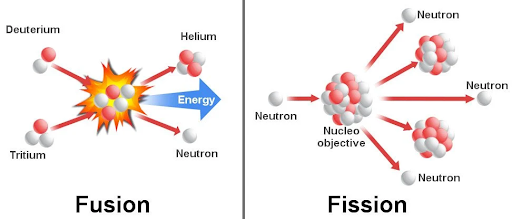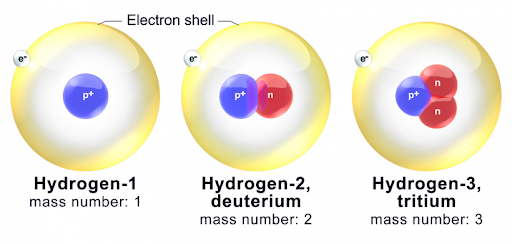Nuclear Fusion
Why in News:
- Scientists in the United Kingdom said they have achieved a new milestone in producing nuclear fusion energy, or imitating the way energy is produced in the Sun.
- A team generated 59 megajoules of sustained energy. 1 Joule (J) is the unit of energy, equal to the force of one Newton acting through one meter.
- A kg of fusion fuel contains about 10 million times as much energy as a kg of coal, oil or gas.
How atomic energy works?

- Atomic energy can be released in two ways – either by breaking up heavy nuclei, like uranium, into smaller fragments, releasing a lot of energy in the process, or by fusing together light nuclei like hydrogen to form heavier stable nuclei and high-energy neutrons which carry a lot of energy that can be harnessed.
- The former process is nuclear fission, and it is what happens in established nuclear reactors around the world.
- The latter is nuclear fusion, and this is the way stars generate energy. In the Sun, for example, hydrogen is being converted into helium, releasing huge amounts of energy. Further, due to gravity, the pressure builds up 200 billion times greater than Earth’s atmospheric pressure, making the density to become 150 times that of water. In this sizzling heat, intense pressure and dense core, the plasma of hydrogen fuse with each other to form helium, unleashing energy in the form of light and heat.
What is nuclear fusion?
-
- It is a nuclear process, where energy is produced by smashing together light atoms. It is the opposite reaction of fission, where heavy isotopes are split apart.
- Fusion is the process by which the sun and other stars generate light and heat.
- In a fusion reaction, two light nuclei merge to form a single heavier nucleus. The process releases energy because the total mass of the resulting single nucleus is less than the mass of the two original nuclei.
- The leftover mass becomes energy. Einstein’s equation (E=mc2), which says in part that mass and energy can be converted into each other, explains why this process occurs.
- It’s most easily achieved on Earth by combining two isotopes of hydrogen: deuterium and tritium.
- Nuclear fusion is a clean and green route to producing energy, as it does not involve any remnant radioactive waste products.
- Fusion reactions power hydrogen bombs.
About the experiment
- The energy was produced in a machine called a tokamak
- Deuterium and tritium, which are isotopes of hydrogen, are heated to temperatures 10 times hotter than the centre of the sun to create plasma.
- This is held in place using superconductor electromagnets as it spins around, fuses and releases tremendous energy as heat.
- The scientific data from these experiments are a major boost for ITER.
Advantages
- Fusion does not emit harmful toxins into the atmosphere such as carbon dioxide or other greenhouse gases. Helium, an inert, non-toxic gas, is the major byproduct.
- There is no danger of a meltdown. It is difficult to achieve and maintain the precise conditions required for fusion, and any disturbance causes the plasma to cool in seconds and the reaction to stop.
- Abundance of energy production.
- Fusion does not use fissile materials such as uranium or plutonium (Radioactive tritium is neither a fissile nor a fissionable material).Hence, Fusion poses limited risk of nuclear proliferation.
- Fusion fuels are abundant and nearly limitless and hence sustainability is present. Deuterium can be extracted from any type of water, whereas tritium is created during the fusion reaction when fusion neutrons interact with lithium.
- There is no long-living high activity radioactive waste produced by nuclear fusion reactors.
Isotopes
Isotopes are members of a family of an element that all have the same number of protons but different numbers of neutrons.
- All elements have isotopes.
- There are two main types of isotopes: stable and unstable (radioactive).
- There are 254 known stable isotopes.
- All artificial (lab-made) isotopes are unstable and therefore radioactive; scientists call them radioisotopes.
- Some elements can only exist in an unstable form (for example, uranium).
- Hydrogen is the only element whose isotopes have unique names: deuterium for hydrogen with one neutron and tritium for hydrogen with two neutrons.

Plasma
- Plasma, in physics, is an electrically conducting medium in which there are roughly equal numbers of positively and negatively charged particles, produced when the atoms in a gas become ionized. It is sometimes referred to as the fourth state of matter
Related Information
Other Experiments Related to Nuclear Fusion
- The International Thermonuclear Experimental Reactor (ITER) Assembly aims to construct the world’s largest tokamak to demonstrate the feasibility of fusion as a large-scale, carbon-free energy source. China, the European Union, India, Japan, South Korea, Russia, and the United States are the members of ITER.
- China’s Artificial Sun: China’s Experimental Advanced Superconducting Tokamak (EAST) device simulates the sun’s nuclear fusion process.
Tokamak
- Keeping the fiery plasma at millions of degrees from touching the container wall is the major challenge in a nuclear fusion reactor. If one can create a magnetic field in the shape of a torus then the scorching plasma could be contained in the invisible magnetic bottle. Based upon this theory, an experimental reactor was built by a Soviet team, called the Tokamak
- One of the critical challenges in the Tokamak is the sudden appearance of plasma instabilities. Hence, the plasma at high temperature needs to be sustained for a long time if commercial energy has to be obtained.
References:
Subscribe
Login
0 Comments
